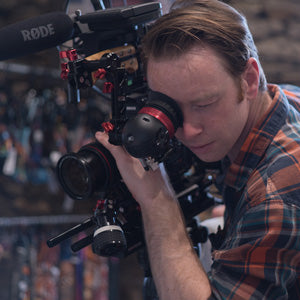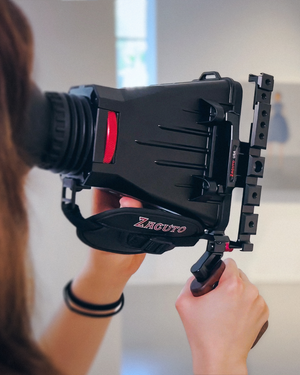
My Gratical Eye Review - a very familiar, but smaller home!
Gear-crazed. There's no denying it. We are living in the age of GEAR. 50 years from now, when we look back on this generation of filmmaking I have no doubt that this term will be applied liberally. It’s neither a positive nor a negative. In my opinion, it’s just a fact. Every time I get up the nerve to pull the trigger and buy a new piece of gear, I fully expect to wake up the next morning to one of the dozens of newsletters I'm somehow subscribed to announcing the release of a product that claims to trump my new purchase in 17 different ways.
This exhaustive pattern of new and newer has over the years led me to greatly appreciate Zacuto, not only for the quality and durability of its products, but also for the precedent of production it has set. Rather than churn out products simply to produce, Zacuto's products have been consistently innovative, high-end and often are improvements to their already existing tools.


 As always, with a smaller build, that means the space to attach the power connections is tight. If you have fat fingers like me, you might find it a little difficult to attach the BNC cable to the SDI input when the 2-pin lemo connector is already attached. With the Gratical HD and X I was a bit spoiled because you have all the room in the world to attach and de-attach BNC or HDMI cables. Again, not a deal breaker since this scenario has been my cross to bear for many years!
Overall, the Gratical Eye is like returning to a very familiar, but smaller home. It is easy to program. There wasn’t a new learning curve. I could find my focus quickly and accurately and I could add and program LUTs if needed. By no means is this a replacement for the Gratical HD or X. It is a specific tool geared for people using professional SDI cameras. Users of the GH4, A7s, C100, DSLR’s and mirrorless cameras will continue to benefit from using the Gratical HD, X
As always, with a smaller build, that means the space to attach the power connections is tight. If you have fat fingers like me, you might find it a little difficult to attach the BNC cable to the SDI input when the 2-pin lemo connector is already attached. With the Gratical HD and X I was a bit spoiled because you have all the room in the world to attach and de-attach BNC or HDMI cables. Again, not a deal breaker since this scenario has been my cross to bear for many years!
Overall, the Gratical Eye is like returning to a very familiar, but smaller home. It is easy to program. There wasn’t a new learning curve. I could find my focus quickly and accurately and I could add and program LUTs if needed. By no means is this a replacement for the Gratical HD or X. It is a specific tool geared for people using professional SDI cameras. Users of the GH4, A7s, C100, DSLR’s and mirrorless cameras will continue to benefit from using the Gratical HD, X
SHOP GRATICAL EYE

Zacuto EVFs
The Zacuto EVF is a sound example of this. I was first introduced to the widely popular Zacuto EVF and have since enjoyed its newer higher-end EVF evolutions: the Gratical HD and Gratical X. Both are a Micro-OLED viewfinder offering many professional options including SDI connection (which the original lacked). The Gratical was designed to be paired with professional grade cameras but still offers input options for those who use DSLRs, C100s or mirrorless cameras. It has now been two years since the HD and the X were released, and once again Zacuto has not disappointed. It has taken what is already an excellent EVF and has sized it down to an even more compact, lightweight professional grade tool. Introducing the Gratical Eye SDI EVF…
Gratical Eye, Gratical X, Gratical HD
I recently had the pleasure of testing out the Gratical Eye while filming a short mini doc series, where the majority of the work is handheld. I paired the Eye with my Canon C300 Mark II and powered it using my Switronix V-Mount L90S. Right off the bat, it’s clear that the Eye is lighter and smaller than my Gratical HD. Form-factor wise I really like it. It doesn’t take up a lot of room in my case, yet the exterior is made up of a robust production grade magnesium alloy that feels sturdy when handled.
Watch my video Gratical Eye review!
Power
Once connected and powered up, the Eye remains on at all times. There is no on/off button. For me this is not ideal, but it's not a deal breaker either, because it doesn’t draw a lot of power; so you won't be burning through batteries. It also comes with a screen saver sensor mode that triggers an auto shut off after 30 minutes of no use.
Differences & Similarities
One complaint I do have is that I was not able to strip my C300 Mark II down to its barebones as I am able to do with my Gratical HD still attached. This is because unlike the Eye, the HD does not need to use an external power source. You can run your HD on LP-E6 batteries all day if you want. With the Eye you don’t have that option. It can only be powered through an external V-mount or Gold-mount battery and as a result you're locked into your shoulder rig at all times. This could be good or bad (or not really matter) for you depending on your shooting style and situation. If it is, the HD or X would be better options for you. Compare the three models here. Menu and display wise, it was like looking at my Gratical HD. The menu is clearly laid out on the left side of the screen. You can access everything you need from your Preset LUTs to scopes and overlays by simply scrolling down a list and selecting the appropriate category by clicking the single button located on the exterior of the eye. As for the the display, the image is crystal clear. I rarely used the Eye’s peaking because the image is sharp enough and clear enough that I felt confident in the image I was seeing. Nothing appeared to be different with inner workings of the Eye compared to the other Gratical models. The Eye, however, has been stripped of its exterior buttons traditionally used to set specific functions. Instead, there is a single button that is used to program directionality (right, left, up, down); the same functions as the HD and the X. I found this to be an improvement because it cuts down on any occasional moments or fumbling when feeling around for buttons in a rushed moment. As always, with a smaller build, that means the space to attach the power connections is tight. If you have fat fingers like me, you might find it a little difficult to attach the BNC cable to the SDI input when the 2-pin lemo connector is already attached. With the Gratical HD and X I was a bit spoiled because you have all the room in the world to attach and de-attach BNC or HDMI cables. Again, not a deal breaker since this scenario has been my cross to bear for many years!
Overall, the Gratical Eye is like returning to a very familiar, but smaller home. It is easy to program. There wasn’t a new learning curve. I could find my focus quickly and accurately and I could add and program LUTs if needed. By no means is this a replacement for the Gratical HD or X. It is a specific tool geared for people using professional SDI cameras. Users of the GH4, A7s, C100, DSLR’s and mirrorless cameras will continue to benefit from using the Gratical HD, X
As always, with a smaller build, that means the space to attach the power connections is tight. If you have fat fingers like me, you might find it a little difficult to attach the BNC cable to the SDI input when the 2-pin lemo connector is already attached. With the Gratical HD and X I was a bit spoiled because you have all the room in the world to attach and de-attach BNC or HDMI cables. Again, not a deal breaker since this scenario has been my cross to bear for many years!
Overall, the Gratical Eye is like returning to a very familiar, but smaller home. It is easy to program. There wasn’t a new learning curve. I could find my focus quickly and accurately and I could add and program LUTs if needed. By no means is this a replacement for the Gratical HD or X. It is a specific tool geared for people using professional SDI cameras. Users of the GH4, A7s, C100, DSLR’s and mirrorless cameras will continue to benefit from using the Gratical HD, X



Leave a comment